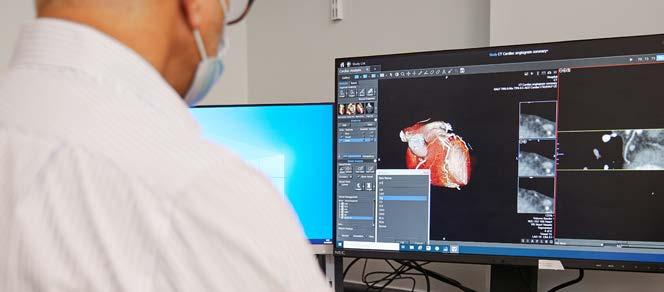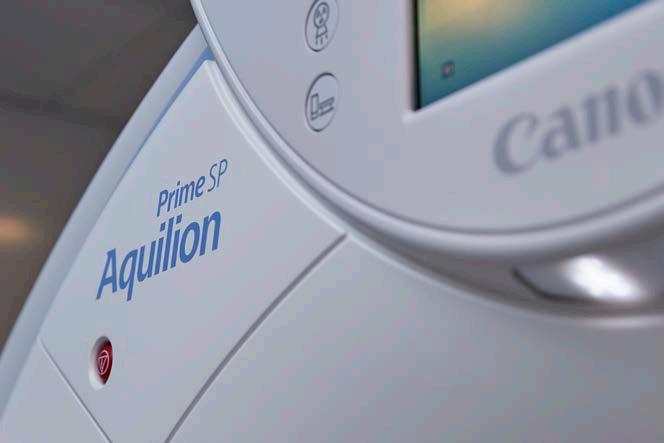
6 minute read
CT: The Exceptional Past The Phenomenal Presents and The Exciting Future
CT: The Exceptional Past, the Phenomenal Present and the Exciting Future
By Mark Thomas, CT Modality Manager at Canon Medical Systems UK
Advertisement
Canon Medical UK recently welcomed the 100th Aquilion ONE CT scanner order of the latest generation, the Aquilion ONE / PRISM Edition.
Fifty years on and the demand for CT is still growing. The first ground-breaking clinical scan dates back to 1971, yet the longevity of CT as an important medical imaging tool is testimony to the ongoing investment and research into developing the systems to meet the greatest healthcare challenges in an ever-changing world.
Today, CT is a core imaging modality in all hospitals with nearly 268 million procedures performed worldwide in 2019, growing to an anticipated 320 million by 2022 . From CT Pulmonary Angiography (CTPA) in COVID-19 patients, to diagnosing heart or brain conditions and guiding tissue biopsies, it is an essential tool in the medical practitioner’s arsenal. It helps to diagnose disease and conditions earlier and to improve life expectancy and outcomes for patients.
This frontline imaging role is set to stay with CT workforces to be expanded and capacity to be doubled over five years as part of the COVID-19 ‘Recovery and Renewal’ reflections report. But there is so much more the future holds for CT. Artificial Intelligence will herald greater rewards with CT; new software applications will answer some of the biggest challenges facing clinical practice; and the sustainable development of CT will evolve in tune with supporting the health of our planet, as well as people. The CT transformation
Recently we welcomed the 100th Aquilion ONE CT scanner order here in the UK, from the latest generation, the Aquilion ONE / PRISM Edition. This milestone is an opportunity to reflect on how far we have come with the system and convey our excitement of what the future holds.
It was just over a decade ago that CT scanning was defined by the number of ‘slices’, referring to the number of rows of detectors in the z-axis. However, the Aquilion ONE burst on to the stage at RSNA in 2007 taking everyone by surprise with its new technological CT innovation. This was the world’s first dynamic volume system far exceeding the industry norms of 64-slice configurations. The competitive slice wars was eliminated forever. Today, to be CT cutting-edge is about the balance of low dose, high speed and clear image quality.
Dose reduction – a game changer for radiology
Since its birth, the Aquilion range of CT scanners has witnessed many changes to the healthcare marketplace – several healthcare reforms; growing patient populations; diminishing radiology workforces; and, not to mention, a global infectious disease pandemic. But CTs’ ability to stay in tune with the changing shape of global healthcare chimes with our

Advanced intelligent Clear-IQ Engine (AiCE), a Deep Learning Reconstruction AI algorithm on CT delivers low dose, extremely high-quality clinical images, and all in a rapid timeframe suitable for everyday clinical use.
philosophy of ‘continuous improvement’ and our commitment to serving the needs of our customers with vast R&D investment.
The introduction of AI-assisted CT has been a game changer for healthcare. Only a year ago the UK’s first CT with Advanced intelligent Clear-IQ Engine (AiCE), a Deep Learning Reconstruction AI algorithm, was installed into a UK hospital, and many more orders have followed since. Our customers have referenced “phenomenal” patient dose reductions, up to 90% below the National Diagnostic Reference Levels, at the same time as benefitting from extremely high-quality clinical images, and all in a rapid timeframe suitable for everyday clinical use. The low doses have even been achieved when examining people that have traditionally been difficult to image, such as severely ill patients with their arms by their sides, those unable to hold their breath and bariatric patients.
AiCE is developed using a deep learning algorithm to differentiate ‘noise’ from true signal, reducing distortions, preserving edges and maintaining details in image outputs at the same time as achieving lower doses than ever before in routine CT imaging. This gives super clear images for radiologists to report on. The low dose is also much healthier for patients, many of which will have many scans over the course of their lives adding to their cumulative dose, given that CT is now a ‘routine’ diagnostic pathway. Recently, the Aquilion ONE / PRISM Edition earnt Frost & Sullivan’s 2020 Best Practices Award for Global New Product Innovation Award in the CT market highlighting its potential in the future of healthcare.
CT in tune with the changing shape of patients
The ever-changing structure of patient populations also means that the design and development of medical equipment needs to adapt. Applications, the software that can be added to the CT hardware, is evolving in response. Take, for example, SEMAR, a Single Energy Metal Artifact Reduction reconstruction technique, mitigates artifacts, radiological distortions from metal objects such as orthopaedic plates or medically implanted coils and provides improved visualization of the soft tissue structures surrounding metal objects. This improves the visualisation of medical images for clinical interpretation with no increased patient dose. A timely innovation with growing numbers of people replacing hips or knee joints and using medical implants.
The external design of CT has also stayed in tune with the changing shape of patients. Table capacity is now at higher weight tolerance adapting to the growing waistlines of UK populations, and the central bore hole of scanners has been getting wider over the last 10 years to accommodate larger patients more comfortably.

Alleviating pressure on clinical workforces
Recognising the growing pressures on radiology workforces is also a key consideration in the design of CT today. The latest Royal College of Radiologists Workforce Report highlighted growing concerns over a 33% shortfall in radiologists, to be 43% by 2024. Yet at the same time, the volume of CT imaging examinations across England has increased by 10% . Radiographer vacancy rates also remain high .
In response to workforce pressures, we continue to innovate CT workflow automation to help give some time savings that over the course of a full day or week, translate into more patient appointment slots. The advancement of AI, as mentioned above, is also a massive time saver to speed up procedures with none of the traditional compromises on image quality or dose.
A future with CT firmly at the heart
A look at the past and present of CT highlights its rise to become a key tool for frontline patient imaging. Its maturity across the wide spectrum of clinical disciplines now underpins many patient diagnosis and treatment pathways.
It is my belief the best of CT is yet to come. The early gains with AI-assisted technologies will develop further and the future of low dose, high speed and amazing image quality will power workflow efficiencies and throughput gains, lightening the load on overwhelmed clinicians and improving the care delivered to, and the life expectancy of, patients. //
Artificial Intelligence Made possible.
Working together to understand your needs and challenges drives valuable outcomes that positively impact you and your patients’ future.

Canon Medical’s vision and commitment to improving life for all, lies at the heart of everything we do. By partnering to focus on what matters, together we can deliver intelligent, high quality solutions.
With Canon Medical, true innovation is made possible.










